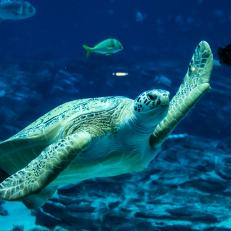Peep Georgia Aquarium's Newest Pufflings
The Georgia Aquarium Puffins just had babies!
Can't make it to see them in person? Take a virtual field trip with us to meet the newest pufflings who call Georgia Aquarium home.
Also, THE AQUARIUM, which ran for two seasons on Animal Planet (2019-2020) and provided viewers with a behind-the-scenes look at Georgia Aquarium, is available in its entirety to stream on discovery+.
September 09, 2021
View The Gallery
1 / 12
This is a puffin egg! After laying their eggs, both puffin parents incubate the egg, and it hatches about 40-42 days later.
This is a process known as ‘candling.’ Georgia Aquarium animal care staff shine a light into the egg to check on its growth and viability. Puffin eggs are grey with purple dots as you can see in this photo.
When a baby puffin, known as a ‘puffling,’ is ready to hatch, they will begin to pip: they make small chirp-like sounds from inside the egg! They use their beak to start breaking the shell.
Like the other animals at Georgia Aquarium, pufflings receive a vet check after they hatch to make sure they are in good health.
This is a horned puffling several days after hatching! Georgia Aquarium has two types of puffin: horned and tufted.
Pufflings’ diets usually consist of sand lances and capelin.
This horned puffling still has its downy chick feathers. About 35 days after hatching, they will start a process known as ‘fledging’ and get their distinct puffin plumage.
This horned puffling can grow up to 12.6 inches in length with a wingspan of about 7.5 inches.
Horned puffins make their nests in crevices, rocks, or burrows.
You may be able to spot the characteristic white belly of adult puffins! This horned puffling will lose its ‘baby’ feathers and grow into its black and white feathers and colorful beak.
Puffins have short, strong wings and legs set far back on the body, making them excellent swimmers and divers. But that can also make them clumsy!
Georgia Aquarium is home to horned puffins (like this puffling), tufted puffins, and two other species of alcids: common murres and pigeon guillemots.














.jpg.rend.hgtvcom.231.231.suffix/1632421591119.jpeg)







